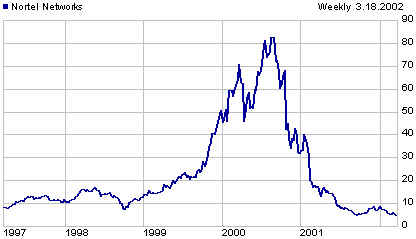Births
which occurred on a March 18:
1992
Windows 3.1 computer operating system is shipped.
^top^
Windows 3.1 became the most popular version of Windows used before
the release of Windows 95. Windows 3.1 came nearly seven years after
the introduction of Windows 1.0, an unimpressive attempt on Microsoft's
part to stay in the race to develop a graphical user interface. During
the mid-1980s, a number of companies, spurred by the introduction
of the revolutionary Macintosh interface in 1984, competed to create
a multitasking, graphical user interface for IBM-PCs. Despite many
competitors, it took years for the graphic environment for PCs to
catch on. Although Microsoft announced Windows in 1983, the product
didn't ship until 1985, and even then, it failed to make a splash.
Meanwhile, Visicorp, the once dominant software company associated
with VisiCalc (the first spreadsheet), was developing VisiOn, a graphic
environment that debuted in 1983 to a resounding flop. Digital Research,
which had led the operating systems niche until DOS took over, devised
GEM, a graphic environment for the PC that also failed to catch on.
It wasn't until Windows 3.0 was introduced in May 1990 that Windows
took off, selling more than three million copies its first year. |
1979 El Partido Conservador Demócrata (PCD) de Nicaragua,
de tendencia socialdemócrata, se funda.
1949 Rodrigo Rato
y Figaredo, político español, vicepresidente segundo y ministro
de Economía.
1936 F.W. de Klerk, 1993 Nobel peace
laureate and former South African president.
1932 John Updike
poet/novelist (Rabbit Run)
1932
John Updike, poet, novelist, in Shillington, Pennsylvania.
^top^
The only child of a math teacher father and aspiring writer mother,
Updike developed an early love for reading and drawing and won a scholarship
to Harvard. He became editor of the famous Harvard Lampoon
and married as an undergraduate. After graduating in 1953, Updike
went to England for a year to study art. In England, he met New
Yorker writers and editors E.B. and Katherine White, who offered
him a job. Updike worked on staff for the illustrious magazine until
1957, when he quit and moved to Ipswich, Massachusetts, to concentrate
on fiction and poetry. He supported his wife and children with contributions
to the New Yorker and in 1958 published his first novel, The Poorhouse
Fair, to favorable reviews. Two years later, he published Rabbit,
Run, considered one of his best novels, about a former high school
basketball star named Harry "Rabbit" Angstrom. He wrote a sequel,
Rabbit Redux, in 1971 and won Pulitzer Prizes for Rabbit
Is Rich (1981) and Rabbit at Rest (1990). Updike's 1968
novel, Couples, detailing the sexual high-jinx of married
couples in a small town, topped the bestseller chart for several weeks.
Updike divorced in 1976 and remarried the following year. The prolific
writer has published 50 books, including novels, children's books,
poetry, and journalism collections. He also writes frequently for
magazines. |
1931 First electric razor is marketed, by Schick
1929 Fidel Ramos, político y militar filipino, presidente
del país.
1928 Hans Kung, teólogo suizo.
1928
José María Setién, obispo de San Sebastián
1927
George Plimpton, author.
1927 Muhammad ben Ahmed
Abdelghani, político argelino.
1911 Gabriel Celaya,
poeta español.
1911 Walter
Ledermann, mathematician.
1910 Chiang Ching-kuo,
son of Chinese generalissimo Chiang Kai-shek, and his successor as leader
of China. He died on 13 January 1988.
1899 Lavrenti Beria
chief of Soviet secret police under Stalin.
1892 Adolf Richard
Fleischmann, German artist who died in 1968 or 1969.
1891 Shewhart,
mathematician.
1881 Barnum and Bailey's Greatest Show on
Earth opens.
1875 Beppe Ciardi, Italian
artist who died in 1932.
1869 Neville Chamberlain
(C) British PM (1937-40). He proclaimed “peace in our times” obtained
at the cost of betraying Czechoslovakia to appease Hitler at Munich in 1938.
His “our times” only lasted a few months, until Hitler decided
to gobble up Poland too. Chamberlain died on 09 November 1940, having outlived
his “our times” by only a couple of months.
1863
William Sulzer, New York governor (1913); impeached and removed
from office. He died on 06 November 1941.
1862 Eugene Fredrik
Jansson, Swedish painter who died on 15 June 1915. — Ring
Gymnast No. 2
1860 Arthur Neville Chamberlain,
estadista británico.
1858 Rudolph Diesel, German
thermal engineer; he invented the internal-combustion engine. He died on
29 September 1913. inventor del motor de combustión interna que lleva su
nombre.
1852
Wells Fargo and Company is founded.
^top^
Businessmen in New York establish Wells, Fargo and Company, destined
to go far as the leading freight and banking company of the West.
The California economy boomed after the discovery of gold at Sutter's
Mill in 1849, spurring a huge demand for shipping. Henry Wells and
William Fargo joined with several other New York investors to create
Wells, Fargo and Company to serve and profit from this demand.
In July 1852, the company began transporting
its first loads of freight between the East Coast and the isolated
mining camps of California. From the beginning, Wells, Fargo and Company
also engaged in banking, making good profits in the traffic of gold
dust and providing loans that helped sustain the growth of the California
economy. The company usually used stagecoaches to move gold dust,
critical business papers, and other express freight quickly. The stages
could carry nine paying passengers, and if the interior seats were
full, a few more hardy travelers could ride on top with the driver.
The traveling conditions were far from luxurious, and passengers had
to tolerate crowding, dust, cold, heat, and the occasional holdup
or Indian attack. Nonetheless, the relatively fast pace of travel
ensured a steady supply of customers.
Wells, Fargo and Company never hesitated to dispatch a rider on horseback
to deliver or pick up an important message or package-provided the
sender was willing to pay a premium price. The company operated several
small "pony express" routes around California, and these were particularly
valuable to the business community during winter, when snow often
blocked stage and rail routes in the Sierra Nevada. In 1866, the company
merged with several other major express and stagecoach lines, including
Ben Holladay's Overland Mail Company.
For the next three years, the expanded Wells, Fargo and Company was
the unquestionable leader in Western transportation, providing speedy
and reliable service at reasonable prices. With the completion of
the transcontinental railroad in 1869, the company's dominant position
was undermined, especially in the transcontinental mail and freight
business. However, Wells, Fargo and Company continued to provide essential
local transportation for decades, and the company still exists today
as a major banking institution. |
1850
American Express is founded ^top^
The brainchild of Henry Wells
and William G. Fargo, American Express was a union of three express
transport concerns: Livingston, Fargo & Company, Wells & Co., and
Butterfield & Wasson. The newly formed, and initially unincorporated,
transportation company was a fast hit with the public; by the close
of the Civil War, American Express had set up 900 offices in 10 states.
Success, however, bred competition, and the upstart Merchants Union
Express Company, founded in 1866, gave American Express a good run
of it for a few years. After two years of furious competition, the
companies decided that it would be more profitable to merge than to
fight; in late 1868, the American Express and Merchants Union joined
together as American Merchants Union Express Company. Fargo took the
reigns of the new concern, which, in 1873, adopted its more familiar
moniker as the American Express Company. American Express, of course,
has since mutated into a giant in the fields of finance and travel,
with offices spread across the globe. |
1844 Nikolai Rimsky-Korsakov, Tikhvin Russia, composer
(Scheherazade, Song of India, The Flight of the Bumblebee)
1842 Stéphane Mallarmé‚ French poet. — MALLARME
ONLINE: MALLARMÉ ONLINE: (French original, page images):
L'après-midi d'un faune : églogue -- L'après-midi
d'un faune : églogue -- Préface
à Vathek -- Album
de vers et de prose -- Pages...
1839 Barbier,
mathematician.
1838 Sir Randal Cremer Britain, trade
unionist, pacifist (Nobel 1903)
1837 Grover Cleveland
(22nd [1885-1889] and 24th [1893-1897] US President, only one to serve 2
nonconsecutive terms; only president to be married in White House; the first
to have a child born there. He died on 24 June 1908.
1834
First railroad tunnel in US is completed, in Penn (275 m long)
1824 Mar 18-1880 Feb 15 Johannes Hendrik Weissenbruch,
German painter who died on 15 February 1880. — LINKS
— Forest
View near Barbizon — The
Shipping Canal at Rijswijk (The View at Geestbrug)
1813
Coal gas making apparatus, patented by David Melville, Newport,
RI.
1798 Francis Lieber, German-born US political
philosopher and jurist who died on 02 October 1872. — LIEBER ONLINE:
Manual
of Political Ethics (page images).
1796 Jakob
Steiner, mathematician.
1782
John
Caldwell Calhoun ^top^
He would be US Vice President
under John Quincy Adams and Andrew Jackson [1825-1832], the first
VP to resign office: became a US Senator
John C. Calhoun was born near Abbeville, South Carolina. Calhoun became
a congressman, senator, secretary of war, secretary of state, and
vice president of the United States. A formidable theorist, Calhoun
was also known for his irascible temperament. Even his protégé James
Hammond allowed that Calhoun was "wanting in judgement in the managing
of men." Calhoun is remembered for his determined defense of the institution
of slavery. During the course of his career, he reversed his stand
as a nationalist and advocated states' rights as a means of preserving
slavery in the South. As a South Carolina senator, Calhoun used the
argument of states' rights to protect slavery in what is known as
the Nullification
Crisis of 1832-1833. Calhoun died on 31 March 1850. |
1733 Friedrich Nicolai, German writer; a leader of the
German Enlightenment. He died on 08 January 1811.
1690 Goldbach,
mathematician.
1640 La
Hire, mathematician.
1609 Frederick III
king of Denmark and Norway (1648-70); absolutist
1602 Billy,
mathematician.
1548 Cornelis Ketel, Flemish painter
who died on 08 August 1616. — LINKS
— Company
of Captain Dirck Jacobsz. Rosecrans and Lieutenant Pauw — Adam
Wachendorff
1452 Amerigo Vespucci (navigator:
said to be the first to discover America: it was actually the coast of South
America including Brazil, Uruguay and Argentina [1497]) |
 On
a March 18:
On
a March 18:  Deaths
Deaths